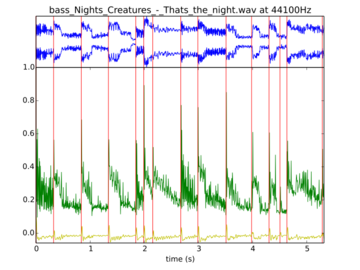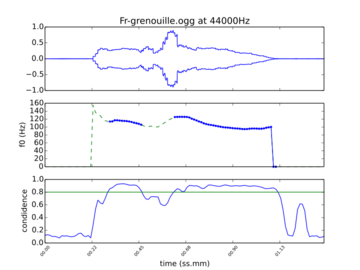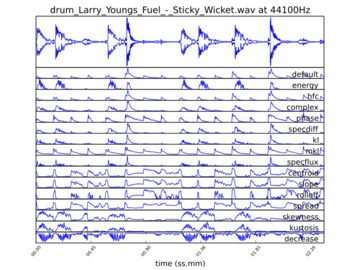aubio
0.4.0 released
After more than five years of development behind the curtain, the time has come to release a new version of aubio.
The list of changes is long, but to make it short, aubio is now:
- more portable: with no required dependencies, the core of aubio library, written in ANSI C, is known to compile and run on most modern platforms (Linux, Windows, Mac OS X, Android, iOS, ...).
- more stable: several bugs fixes and a battery of tests make this new release more robust and less prone to errors.
- faster: several enhancements to the C library and a brand new Python interface help make this release orders of magnitude faster than the previous ones.
Several new features have been added, including:
- the new source object uses libav to read audio samples from any audio or video file, compressed or uncompressed, including over different network protocol. (On Apple systems, decoding of most audio formats is also possible using CoreAudio).
- a new filterbank object, completely customizable, allows for computing energies in any number of custom designed spectral bands.
- a new mfcc object computes the Mel Frequency Cepstrum Coefficients (MFCC). It is implemented according to Malcom Slaney's Auditory Toolbox.
- new spectral descriptors, including statistics such as centroid, skewness, slope, decrease, rolloff, and kurtosis.
- new simple synthesis objects provide basic ways of generating sounds
An audio example is worth a thousand characters. Here are a few examples of graphs obtained using the new Python interface.
Examples of plots obtained using aubio's new Python interface. From top to bottom, left to right: a. Onset detection on recording of an electric bass guitar with distortion. The original waveform is shown in the upper part, while the lower part shows the onset detection function (green), the thresholded function (yellow), and the detected onsets (red) (source code). b. Pitch detection on a male voice. The middle plot shows the detected f0 (dashed green) and the detections for which the confidence is higher than a given threshold (blue). The bottom plot shows the confidence for each frame (blue) and the confidence threshold (green) (source code). c. Energies found in 40 bands equally spaced on the Mel scale, obtained on a sample containing a guitar and a keyboard (source code). d. Different spectral descriptors computed on a drum loop, showing the behavior of these functions for different percussive sounds (source code).
Sound samples credits and references:
Download aubio 0.4.0
Merry hacking!
Tue, 17 Dec 2013, 19:00. trackback - view/add comments
Responses to this post
I wonder if you could give some guidance on upgrading Denemo to use 0.4.0?
The onset detection is used in the file sourceaudio.c which is used to synchronize audio with a notated score:
http://git.savannah.gnu.org/gitweb/?p=denemo.git;a=blob;f=src/sourceaudio.c;h=69b782dcda56c2ced7532372664a67245cdb79f3;hb=HEAD
we also have pitch detection stuff in the file pitchrecog.c to allow input of notes to a score from a microphone.
Richard Shann
Posted by Richard Shann at Mon Jan 20 19:55:19 2014
Leave your own comment
© 2003-2017 the aubio team | cc-by-sa



